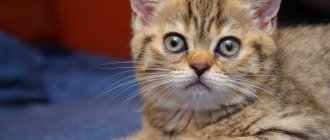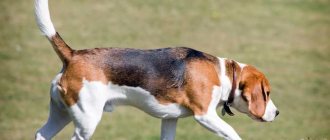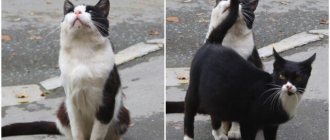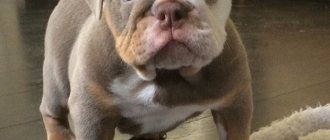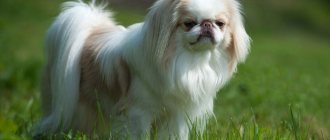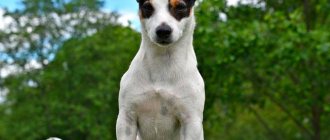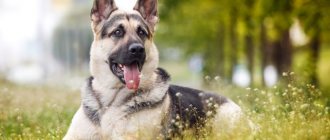Description of the English Setter breed
Popularity 145th place among 263 dog breeds
Lifespan:
10-12 years
Breed group:
Cops
Height:
males: 65-68 cm, females: 61-65 cm
Country of origin:
Great Britain
Average price:
40-50 thousand rubles
Weight:
males: 25-36 kg, females: 20-32 kg
Latest articles Cat health
Ataxia in cats: what is it, how does it manifest and is treated 01/23/2022 180 0 0
Cat health
Leukemia, or viral leukemia in cats 01/23/2022 156 0 0
Key facts
Long-haired pointing dogs are excellent bird hunters. Characteristics of the English Setter breed mentions, in addition to high praise for its excellent scent and endurance, that the dogs are considered true aristocrats among representatives of hunting breeds. These combinations make the breed a favorite not only among dog breeders, but also among hunters.
The increased activity of a dog does not make it intrusive towards others. She will be a good companion for both active and elderly people. The main thing is not to leave your pet unattended for a long time. It is difficult for a setter to live without participation in the life of the owner or members of his family.
He is childishly playful, so he will gladly take part in fun or catch-up with his little owners. At the same time, parents can rest assured, because it is difficult to find a better nanny dog than an English setter.
The description of the English Setter breed says that the four-legged friend treats everyone who lives or is near him well. The feeling of competition is alien to him, so he will happily accept any animal as a neighbor. An Englishman would rather lick even a stranger than bark. This indicates his inability to be a caretaker.
These pets live equally comfortably in country houses or apartments if you provide them with sufficiently long walks. Having appeared in Great Britain, setters were named after their country of origin.
Bitches are traditionally smaller than males. The weight of a female English setter ranges from 20 to 32 kg, a male – from 25 to 36 kg. The height at the withers of males is 65-68 cm, girls grow no higher than 65 cm. For a number of reasons, the life expectancy of the English Setter is low, up to 12 years, but there are individual specimens whose age reaches 14 years.
Walk
The four-legged dogs of this breed are extremely active and require long walks, during which the energy accumulated during the day splashes out. A walk lasting at least an hour would be optimal. If the animal is used as an exhibition specimen, then 2-3 hours a day is quite enough.
Important! If the dog is intended to participate in hunting, then walks should be longer, and better - in the countryside.
Setters do not tolerate extreme weather conditions very well. In hot weather, the dog is protected from overheating, and in cold and damp weather, the pet is put on a warm, waterproof pad or overalls.
History of the origin of the English Setter
Lively debate about the origin of the breed is still going on. There are two main points of view: some believe that the dog originated from Spanish ancestors, others suggest that the ancestors were modern spaniels. The only thing that breeders agree on is the country of origin.
It must be said that the second version of the appearance of setters has significantly more supporters. During the Renaissance, spaniels were very popular throughout Western Europe. Then the breed was divided into two types: water, for hunting in swamps, and field, working on land.
The most famous in those days were the setting spaniels. They would sneak up on the prey and make a stand so that the owner could throw a net over the bird. It was the working qualities of the dogs that interested breeders, but few people cared about the exterior of the new breed. Therefore, retrievers, greyhounds, and even poodles took part in the creation of the breed. Thus, the animals became quite heterogeneous, but retained excellent hunting qualities.
At the beginning of the 19th century, the appearance of dogs led dog breeders to some confusion. They noticed that the color of a setter often depends on its territory of residence. Therefore, black individuals with red tan spots became Scottish Gordon Setters, red-piebald and chestnut-red ones were called Irish, but white ones with orange, brown or black markings settled in the south of England and became English.
Edward Laverack, an experienced dog breeder and passionate hunter, began working on the appearance of the latter. He crossed two individuals purchased from the same owner. Using the method of inbreeding, that is, the mating of four-legged animals that are related, Laverack wanted to improve the breed. It took him about 50 years for the selection to end with an excellent result. An elegant and very graceful breed of English Setter was presented to the public.
Another breeder and breeder, Edward Laverack's compatriot Richard Llewellyn, took a different path. He decided to improve the breed by mixing setter blood with other breeds of hunting dogs. Both enthusiasts clashed due to their rejection of each other’s methods and each engaged in breeding independently. Therefore, two branches of the English Hunting Dog breed arose, named after their breeders.
At the 1859 exhibition in Newcastle upon Tyne, setters were officially introduced to the public. They began to take part in various events and soon became a popular breed not only in the UK, but also abroad. Since the 1870s, the English Kennel Club recognized the breed and began to keep a pedigree of dogs.
Animals became widespread among aristocrats and intelligentsia. An interesting fact is that in Tsarist Russia setters were among the favorites of Nicholas II; they were kept by A. Blok, I. Bunin, A. Kuprin. The second wave of popularity of English hunters in our country occurred at the end of the 20th century and continues to this day.
Appearance of the English Setter
General impression
Setters are a medium-sized breed with clear sexual dimorphism. This means that females are more gentle, refined and graceful than males. But at the same time, individuals of both sexes are very proportionally built, and also have a lean physique, this is clearly visible even in the photo of the English setter.
Head
The dog's small head has a high and proud stance. The oval skull has a pronounced occipital protuberance, as well as a wide frontal part. The brow ridges protrude slightly forward.
The dog's muzzle looks noticeably narrower in comparison with the skull. It has a square type because the size from the stop to the back of the head coincides with its length.
The nose has a clear, straight back. The brown or black lobe has wide nostrils, providing the hunter with an excellent sense of smell. The lips of the individual are tightly attached to the jaws.
The dog's velvety ears appear narrow and have a triangular shape. Located at eye level, slightly directed towards the back of the head. Dark, deep-set eyes look intelligent, expressive. The pet's strong white teeth are located in one line.
Neck
A neck set high enough is characterized by increased flexibility. If you look at the animal from the front, you can see its slightly oval cross-section and convex scruff.
Torso
Despite its medium size, the setter's body looks graceful, light, and also very balanced. In the area of the croup and shoulder blades, the curves of the muscular back are clearly visible. The chest with dry muscles takes on a finished appearance by the age of three years of the pet’s life. Long, slightly convex ribs make the chest look full. The back merges into a slightly arched lower back. The croup with smooth outlines is quite sloping, and the belly is tucked in and makes the dog’s bottom smooth.
Forelegs
Long, muscular legs are located parallel to each other. The shoulders are connected to the shoulder blades at right angles. There is no gap between the chest and elbows. The metacarpus are of medium length, the fingers end in strong claws.
Hind limbs
When standing, they are directed backwards and have strong, lean muscles. The rounded paws end with slightly convex pads. The fur that fills the spaces between the toes is most often clipped.
Tail
The tail, located slightly below the back line, is a natural continuation of it. It can be shaped like a saber or a straight line tapering to a point. During hunting or during periods of excitement, the tail is located almost parallel to the ground, the rest of the time it is lowered. The setter's tail resembles a feather due to the long, wavy hair on its lower part.
Movement
The animal's strong, muscular legs are designed to overcome long distances. The dog is famous for its great endurance. Her movements are sharp and powerful. When accelerating, the pet places its paws closer to the middle. The dog easily jumps over obstacles thanks to the powerful pushes of its hind legs. All movements of the setter look graceful and easy.
Wool
By the age of two, representatives of the English breed acquire an excellent coat. The length of the hair depends on its location. Short hair is located on the head and the front of the paws. On the body it is slightly elongated, but the thickest, longest hair is in the area of the ears, on the chest and tail of the individual.
Color
The mottled color of the English Setter comes in two types: brown-yellow and black-and-white. Sometimes there is a tricolor one. Smaller specks make the individual more valuable. The spots should be located fairly evenly over the entire surface of the pet’s body.
Size
Females grow up to 65 cm, males are slightly taller. Their height at the withers reaches 68 cm. The height of the English Setter is stipulated by the standards. Females weigh on average 20-32 kg, males weigh 25-36 kg. In general, the compact size of the English Setter determined their popularity among hunters and dog breeders.
Existing colors
A pet’s full coat color does not appear immediately. The growth of fur lasts throughout the animal’s youth and is completed only by the age of 3. The fur is distributed unevenly over the pet's body and limbs. Elongated areas are located under the tail, on the ears, chest, limbs, and abdomen. On the head, back, and parts of the forelimbs, the hair is shortened.
The breed is characterized by a speckled color, called “belton” by dog handlers. The main color is white. On top of it are spots of various shapes, sizes, and colors. The following shades are possible: black, blue, lemon, orange, brown. Three-color color options are acceptable.
According to the standard, the spots should be distributed evenly over the dog's body and limbs. Another condition is that the fewer spots on the “Englishman”, the better.
Character of the English Setter
Based on reviews from four-legged owners, we can say that the setter is perhaps the most affectionate, friendly and open hunting breed. Pets are often too strongly attached to a person, constantly hovering under the owner’s feet, trying to take an active part in all his affairs. Therefore, the dog becomes an excellent companion not only on long walks, but also enjoys watching TV with the family.
The animal will show no less love towards strangers who come to visit. They will get a lot of kisses and affection from the cop. She will calmly react to hugs from a stranger.
One of the disadvantages of such sociability is their fear of separation and fear of loneliness. To ensure that your pet’s mental and physical health is in order, you should not leave it unattended for a long time. This is the most terrible punishment for a pet and greatly affects its emotional state.
Representatives of this breed are completely unsuitable for the role of watchmen. They are ready to see potential friends in all people, so they will not defend their territory. Special education will help correct the excessive friendliness of an Englishman, but you shouldn’t count on it too much.
Setters get along well with other animals living with them in the same house or apartment. Jealousy is not typical for these four-legged animals. They will perceive any living creature as a friend who will help them not to be bored alone, and will also become an excellent partner in games and mischief. A dog can only harm rodents or birds that are kept by its owners. She will do this by pure chance, during the game.
Children especially love setters, and they respond to them with no less tenderness. Spending time with their little owners, running with them, walking with them is a great pleasure for dogs, which they are unlikely to exchange for anything. The character of the English Setter can be called sweet and very friendly; aggression is not typical of the breed at all.
A Dog's Unique Trait
From English, “setter” is translated as “crouching”. The breed received this name due to its unusual manner of movement. When running, dogs push off the ground by flexing their hind limbs. For a few moments they assume a sitting position. Their movement resembles constant squats, for this reason the dogs are nicknamed setters.
According to another version, the name of the breed comes from the English word “set” - “to set”. When the pet notices prey, it stands up, showing the owner the location of the game.
A unique feature of the animals is their unusual hunting behavior. When the pet smells game, it begins to move softly and slowly so as not to scare away the prey. As the aroma intensifies, the dogs' movements become more graceful and cautious.
Education and training
English setters are considered to be highly trainable. Quite obedient animals perceive human commands and demands quite well, but increased activity will make the learning process difficult.
Education and training of the English Setter should begin from the first days the puppy appears in the family. To begin with:
- accustom the dog to the toilet and hygiene standards;
- teach you to respond to the owner’s voice and your nickname;
- develop the ability to walk on a leash while walking.
It is very important that training and feeding are handled by one person, that is, the owner. This will make it easier for the baby to get used to the requirements. They must be presented consistently and firmly, without making concessions, otherwise the pet will not understand what is needed from him.
You should not shout at the puppy or praise him too much, because the dog easily gets used to such extremes of upbringing and it will be quite difficult to cope with him in the future.
Thanks to the high intelligence of the pet, it is easy to accustom it to different commands in a short time. But his keen mind also allows him to selectively fulfill the owner’s demands. If the setter doesn’t like something, it’s unlikely to force him to do it.
Learning ability
Training a setter is not easy - the dog reacts sharply to the slightest changes in the tone of voice and behavior of the owner. He is ready to work only in a calm environment - any scream, spank or punishment will be a reason to stop training.
The active disposition of a laverak can become a reason for the owner's dissatisfaction - but there is no need to punish the dog, especially a young one, for showing emotions. It is better to let the dog “let off steam” before training, run around and only then give commands.
The setter must know and automatically execute prohibiting commands and the “come to me” command. Thanks to his keen sense of smell, he perfectly smells the smell of stale “goodies” on the street, as well as small cats and birds, and at any second he can chase them. This is where a well-practiced skill comes in handy - any manifestation of the hunting instinct must be controlled.
The dog cannot live in a cage or enclosure - it needs constant contact with a person. In an apartment, the setter must be able to move freely around the rooms, otherwise he will begin to chew things and furniture.
English Setter
English Setter Health and Diseases
Possible diseases
The crossing of strong and genetically healthy individuals led to the creation of a breed with excellent health. However, setters are still susceptible to some diseases:
- congenital digestive problems;
- inflammation of the uterus;
- hip dysplasia;
- paralysis of the hind or fore limbs;
- congenital or acquired deafness;
- inflammatory diseases of the ears;
- skin and food allergies;
- retinal atrophy.
Good immunity of pets must be maintained with preventive and routine vaccinations against distemper, parvovirus, hepatitis, trichophytosis and coronavirus. For hunting dogs, annual rabies vaccination is required. Preventing ticks and other parasites will help keep your dog healthy for many years.
Reproductive health
The best time for mating males and females is two years of age. It is then that individuals of this breed fully mature sexually. By the age of two, bitches go into heat for the third time.
Sterilization of female pets can be carried out after the first heat, that is, after a year of life.
Mating
The best age for the first mating for females and males is 2 years. Until this time, it is not recommended to breed males; this will not improve the health of the future offspring.
The couples meet on neutral territory so that the animals can run around. Before mating, active walking is required. Feeding, on the contrary, is undesirable. Mating is carried out on the territory of the dog. The duration of pregnancy is from 58 to 65 days . There are an average of 6 puppies in a litter.
Features of feeding and diet
Setters are not prone to obesity. Feeding rates can be easily determined by observing your pet. If he greedily licks an empty bowl, then the portion should be increased. Dogs do not suffer from overeating due to their innate aristocracy.
The basis of their menu should be protein obtained from lean meats or low-bone sea fish. Before feeding the dog, food should be cut into small pieces and scalded with boiling water; cooking until fully cooked is not recommended. It is useful to combine meat products with crushed rice and buckwheat, and oatmeal. They should be prepared in the form of porridges, adding vegetables. Carrots and pumpkin are especially beneficial for dogs' health. Fruits are also necessary in the setter's diet.
The owner decides what to feed the pet. Some people prefer dry food to natural food. It is important to purchase high-quality premium food, enriched with vitamins and beneficial mineral supplements. If the owner prepares food for the dog himself, the necessary vitamin complexes must be added. For a beautiful coat, it is useful to introduce fish oil into your diet.
From the age of one month, the menu must include low-fat fermented milk products and fresh cottage cheese. Sweets, berries, tubular bones and raw eggs are prohibited from being given to dogs.
Care and maintenance
Setters require daily and careful grooming. First of all, the animal's fur needs it. Your four-legged friend sheds several times a year, so a long-haired dog is not suitable for allergy sufferers. Frequent wet cleaning of the pet's place of residence should be mandatory.
Thorough brushing of your pet's hair should be done daily. It is best to remove dead hair with a natural bristle brush or a wooden comb: this will not only prevent the formation of tangles, but will also provide a relaxing massage for your pet.
You should periodically visit special salons for trimming long hair. This must be done at least once every five weeks. Representatives of this breed are not fully or partially cut. Violation of exterior standards is possible only in case of severe neglect of the animal.
Washing your four-legged friend should be infrequent. Its hair is covered with a thin layer of fat that prevents exposure to water or dirt. Therefore, even the mildest specialized shampoo can break the protective barrier. Waterproof overalls, which are worn on the dog in wet weather while walking, become a salvation from dirt.
After walks, the setter's eyes are washed with boiled water or tea. This procedure will help avoid inflammatory processes from accumulated dust and debris.
Once a month, the pet’s claws are trimmed, because they do not have time to grind them down on their own, preferring to run on soft ground rather than on asphalt. Use a nail clipper to cut the tip of the nail, and use a nail file to smooth out the uneven edges.
Your setter's teeth should also be kept in good condition by cleaning them with a finger brush and pet toothpaste. Bones and cartilage are given to puppies to develop a strong jaw. The rules for the care and maintenance of an English Setter must be clearly understood not only by the owner, but also by the dog itself. This will make life easier for both parties.
Tips for choosing a puppy
Only nurseries for breeding English setters will help you purchase a purebred puppy. The price for purebred individuals is high, but for this money you can get a baby with an excellent pedigree and excellent health.
When purchased at the poultry market, the cost will be noticeably lower, but no one will guarantee the purity of the breed.
When making a choice, we must remember that English Setter puppies are born without the characteristic markings, which begin to appear with age.
Before purchasing a pet, you need to observe its behavior and style of play, ask to see the baby’s parents, and look at veterinary documents. This will help determine how healthy the future pet is and find out whether it meets the basic standards of the breed.

